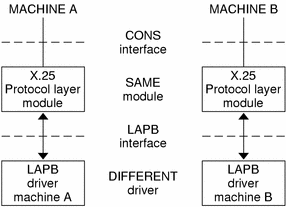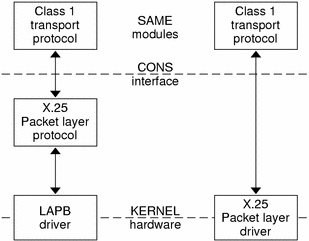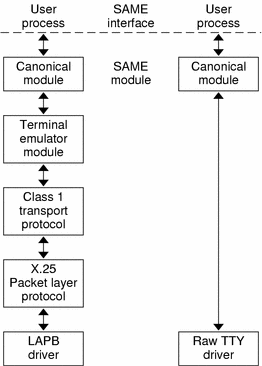Structure of a Message Queue
A queue is an interface between a STREAMS driver or module and the rest of the stream (see queue(9S)). The queue structure holds the messages, and points to the STREAMS processing routines that should be applied to a message as it travels through a module. STREAMS modules and drivers must explicitly place messages on a queue, for example, when flow control is used.
Each open driver or pushed module has a pair of queues allocated, one for the read side and one for the write side. Queues are always allocated in pairs. Kernel routines are available to access each queue's mate. The queue's put or service procedure can add a message to the current queue. If a module does not need to queue messages, its put procedure can call the neighboring queue's put procedure.
The queue's service procedure deals with messages on the queue, usually by removing successive messages from the queue, processing them, and calling the put procedure of the next module in the stream to pass the message to the next queue. Chapter 7, STREAMS Framework - Kernel Level discusses the service and put procedures in more detail.
Each queue also has a pointer to an open and close routine. The open routine of a driver is called when the driver is first opened and on every successive open of the stream. The open routine of a module is called when the module is first pushed on the stream and on every successive open of the stream. The close routine of the module is called when the module is popped (removed) off the stream, or at the time of the final close. The close routine of the driver is called when the last reference to the stream is closed and the stream is dismantled.
Configuring Multiplexed Streams
Previously, streams were described as stacks of modules, with each module (except the head) connected to one upstream module and one downstream module. While this can be suitable for many applications, others need the ability to multiplex streams in a variety of configurations. Typical examples are terminal window facilities, and internetworking protocols (that might route data over several subnetworks).
An example of a multiplexer is a module that multiplexes data from several upper streams to a single lower stream. An upper stream is one that is upstream from the multiplexer, and a lower stream is one that is downstream from the multiplexer. A terminal windowing facility might be implemented in this fashion, where each upper stream is associated with a separate window.
A second type of multiplexer might route data from a single upper stream to one of several lower streams. An internetworking protocol could take this form, where each lower stream links the protocol to a different physical network.
A third type of multiplexer might route data from one of many upper streams to one of many lower streams.
The STREAMS mechanism supports the multiplexing of streams through special pseudo-device drivers. A user can activate a linking facility mechanism within the STREAMS framework to dynamically build, maintain, and dismantle multiplexed stream configurations. Simple configurations like those shown previously can be combined to form complex, multilevel multiplexed stream configurations.
STREAMS multiplexing configurations are created in the kernel by interconnecting multiple streams. Conceptually, a multiplexer can be divided into two components--the upper multiplexer and the lower multiplexer. The lower multiplexer acts as a stream head for one or more lower streams. The upper multiplexer acts as a device for one or more upper streams. How data is passed between the upper and lower multiplexer is up to the implementation. Chapter 13, STREAMS Multiplex Drivers covers implementing multiplexers.
Multithreading the Kernel
The Solaris operating environment kernel is multithreaded to make effective use of symmetric shared-memory multiprocessor computers. All parts of the kernel, including STREAMS modules and drivers, must ensure data integrity in a multiprocessing environment. For the most part, developers must ensure that concurrently running kernel threads do not attempt to manipulate the same data at the same time. The STREAMS framework provides multithreaded (MT) STREAMS perimeters, which provides the developer with control over the level of concurrency allowed in a module. The DDI/DKI provides several advisory locks for protecting data. See Chapter 12, Multithreaded STREAMS for more information.
Service Interfaces
Using STREAMS, you can create modules that present a service interface to any neighboring module or device driver, or between the top module and a user application. A service interface is defined in the boundary between two neighbors.
In STREAMS, a service interface is a set of messages and the rules that allow these messages to pass across the boundary. A module using a service interface, for example, receives a message from a neighbor and responds with an appropriate action (perhaps sending back a request to retransmit) depending on the circumstances.
You can stack a module anywhere in a stream, but connecting sequences of modules with compatible protocol service interfaces is better. For example, a module that implements an X.25 protocol layer, as shown in Figure 1-6, presents a protocol service interface at its input and output sides. In this case, other modules should be connected to the input and output side if they have the compatible X.25 service interface only.
Manipulating Modules
With STREAMS, you can manipulate modules from the user application level, interchange modules with common service interfaces, and change the service interface to a STREAMS user process. These capabilities yield further benefits when working with networking services and protocols:
User-level programs can be independent of underlying protocols and physical communication media.
Network architectures and higher-level protocols can be independent of underlying protocols, drivers, and physical communication media.
Higher-level services can be created by selecting and connecting lower-level services and protocols.
The following examples show the benefits of STREAMS capabilities for creating service interfaces and manipulating modules. These examples are only illustrations and do not necessarily reflect real situations.
Protocol Portability
Figure 1-6 shows how an X.25 protocol module can work with different drivers on different machines by using compatible service interfaces. The X.25 protocol module interfaces are Connection Oriented Network Service (CONS) and Link Access Protocol - Balanced (LAPB).
Figure 1-6 Protocol Module Portability

Protocol Substitution
You can alternate protocol modules and device drivers on a system if the alternates are implemented to an equivalent service interface.
Protocol Migration
Figure 1-7 shows how STREAMS can move functions between kernel software and front-end firmware. A common downstream service interface lets the transport protocol module be independent of the number or type of modules below it. The same transport module will connect without modification to either an X.25 module or X.25 driver that has the same service interface.
By shifting functions between software and firmware, you can produce cost-effective, functionally equivalent systems over a wide range of configurations. This means you can swiftly incorporate technological advances. The same transport protocol module can be used on a lower-capacity machine, where economics preclude the use of front-end hardware, and also on a larger scale system where a front-end is economically justified.
Figure 1-7 Protocol Migration

Module Reusability
Figure 1-8 shows the same canonical module (for example, one that provides delete and kill processing on character strings) reused in two different streams. This module would typically be implemented as a filter, with no service interface. In both cases, a TTY interface is presented to the stream's user process because the module is nearest the stream head.
Figure 1-8 Module Reusability





